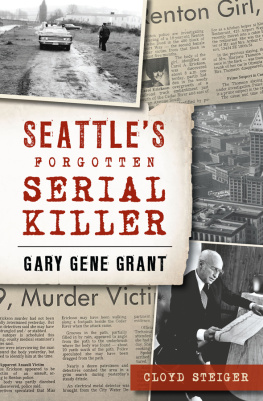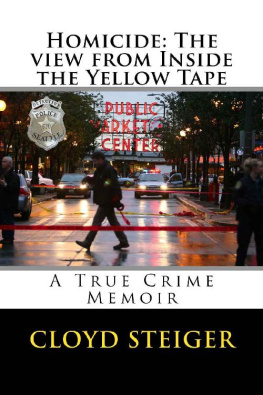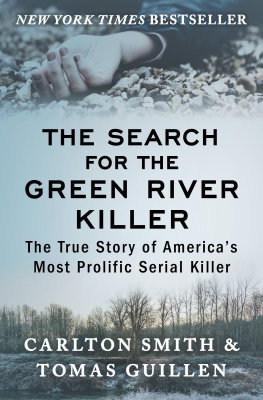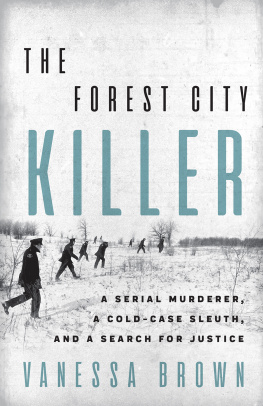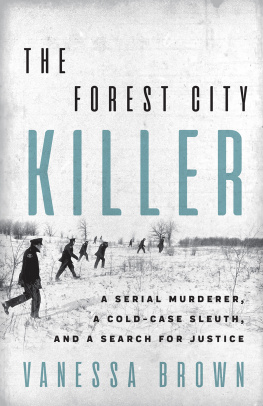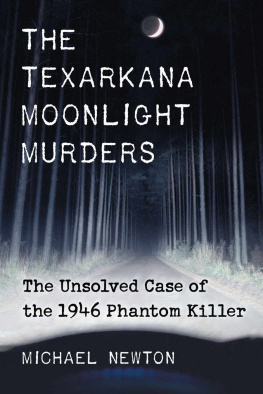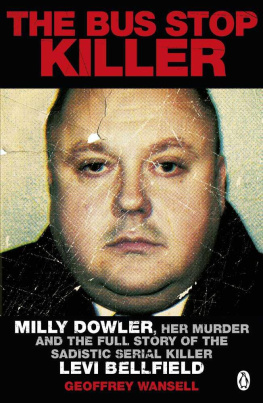

Published by The History Press
Charleston, SC
www.historypress.com
Copyright 2020 by Cloyd Steiger
All rights reserved
First published 2019
E-Book edition 2019
ISBN 978.1.43966.885.6
Library of Congress Control Number: 2019951255
Print edition ISBN 978.1.46714.362.2
Notice: The information in this book is true and complete to the best of our knowledge. It is offered without guarantee on the part of the author or The History Press. The author and The History Press disclaim all liability in connection with the use of this book.
All rights reserved. No part of this book may be reproduced or transmitted in any form whatsoever without prior written permission from the publisher except in the case of brief quotations embodied in critical articles and reviews.
When I close my eyes, I can see all these things happening, like I were a movie camera
Gary Gene Grant psychiatric evaluation, June 1971
CONTENTS
ACKNOWLEDGEMENTS
When I was asked to write this book, I looked for people directly involved in the case who could help me fill in the blanks the case file could not. I quickly found that many of the people who worked on, prosecuted or were affected by the Gary Grant case had passed away.
I reached out to current Renton mayor Denis Law, who put me in contact with the Renton Historical Society and its curator, Dr. Elizabeth Stewart. She was very helpful in giving me not only information about this case but also other historical facts about Renton.
Renton councilmember and retired Renton police assistant chief Don Persson gave me great insight into the Renton Police Department during those times. He also linked me to John Pavone, who had been a detective with the police department and worked on the Grant case.
Jim Phelan was gracious in sharing his memories of the investigation, including insights that didnt come out in the official case file.
Wally Hume, who had a significant role in the case, also told me what he remembered, after saying, Ive spent years and years trying to forget this case but still having the inside information I was looking for.
Elected King County prosecutor Christopher Bayley was instrumental in relaying his thoughts about this notorious case that came to light just weeks after he took office.
Although Special Prosecutor Edmund Allen had passed away just a year before I started this project, his son, Edmund Allen Jr., himself an attorney and former King County prosecutor, was very helpful in describing the conversations he had with his father about this incident and how deeply affected the elder Allen was by the case.
Michael DiJulio and I crossed paths many times when I worked as a homicide detective and he as a longtime prosecutor. His insights into the case were equally invaluable.
Casey McNerthney is a friend and longtime reporter/executive producer in the Seattle news market who helped me with research and gave me useful contacts to complete this book.
Lastly, I cant write this book without acknowledging the anguish suffered by the friends and families of Carol Erickson, Joanne Zulauf, Scott Andrews and Bradley Lyons. Their suffering is that of often-overlooked secondary victims of homicide: the loved ones left behind.
INTRODUCTION
Throughout the years, people have been fascinated by serial killers. From the Whitechapel murders of Jack the Ripper to the more modern John Wayne Gacy, Ted Bundy, Wayne Williams (the Atlanta Child Murderer) and Gary Ridgway (the Green River Killer), these cases have demanded the attention of the masses with various books, documentaries and articles written about the incidents. Although these killers account for a scintilla of the murders committed in the United States, criminologists have committed their academic lives to the study of these human enigmas to see what makes them tick.
In this age of vast information resources, most of these killers are well known to the students of this type of crime. Volumes have been written about them and are only a mouse-click away for anyone interested in researching them. Many serial killers names are well known to those who study them, either as a hobbyist or an academic. People are often surprised to learn that the vast majority of serial killers are not generally known by the public.
Even though I was a longtime homicide detective who worked on serial murder cases and studied many others, there are known serial killers who Ive never heard of. To have one who operated in the Seattle area who I hadnt heard of was surprising; I thought I knew most of the local suspects.
A year before I wrote this book, I received an e-mail from someone who had read my first book, Homicide: The View from Inside the Yellow Tape: What do you know about Gary Grant, who killed two teenaged girls and two small boys in Renton in the late sixties or early seventies?
Though I thought I knew about most if not all of the serial killers in Washington State, I had never heard of Grant. Inquiries to the Renton Police Department and King County Sheriff s Office revealed only a small, incomplete footprint of the crime.
When I contacted the King County Prosecutors Office, it had the court file for the case and allowed me to copy it for submission to the Homicide Investigations Tracking Systems database where I currently work.
Later, when The History Press asked if I would write a historical true crime book from the Seattle area, this case immediately came to mind.
Besides poring over the case file, I tried to find people who were associated with this case. Many had passed away. I was able to find some, like Detectives Wally Hume and John Pavone, as well as then-sergeant Jim Phelan, who had personally worked on the case. Don Perrson was an officer and later assistant chief and Renton City Council member and discussed with me the Renton Police Department at the time and how this case affected the city and the department.
Edmund Allen, who was appointed as special prosecutor for this case, had passed away the year before I began working on this book, but his son, attorney Edmund Allen Jr., related some of the many conversations he had with his father over the years about the Grant case.
Former elected King County prosecutor Christopher Bayley shared his memories of the case, some of which he detailed in his book, Seattle Justice: The Rise and Fall of the Police Payoff System in Seattle. Michael DiJulio, who prosecuted this case with Allen, shared his insights.
Judge David Soukup, who presided over State v. Gary Gene Grant, was still around; I spoke to him about the case and how his rulings kept Grant from walking free after serious errors by a member of the Renton Police Department.
Slowly, the case emerged for me. Speaking with those still around who worked the case, I learned that they still had fresh memories of it. It had made an indelible mark on their collective minds.
With the benefit of twenty-twenty hindsight, I learned about the case, about mistakes made and the excellent detective work done by investigators with little or no experience in working on a crime of this magnitude without all the modern forensic tools available today.
And I learned about Gary Gene Grant: Seattles forgotten serial killer.
CAROL
December 1969 was a turbulent time in America. Richard Nixon was finishing his first year in the presidency while protests filled the streets of major cities across the country because of the Vietnam War.
Next page
